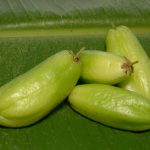Mutandabota is a dairy product which is similar to porridge or yogurt and is consumed as a major source of proteins and micronutrients in Southern Africa. The traditional form is the non-fermented version and is consumed daily mainly by children. The traditional version is made from milk (79 percent w/w), dried baobab fruit pulp (14 per cent w/w) and sugar (7 percent w/w). It generally already has a microbial load of mesophilic bacteria, lactobacteria and yeasts.
The flavour is sour with a slight fruity overtone and has a pH of 3.4 to 3.5 due to acidification by the added fruit pulp. The addition of baobab with its high fibre content makes it suitable as a health food. According to Mpofu et al., (2014b), the nutrient content is the following:-
- protein 4.8 grams/100g
- fat 2.8 g/100g
- fiber 1.1 g/100g
- ash 0.9g/100g
- carbohydrates 20g/100g
- vitamin C 80mg/100g
Yoba mutandabota is milk from buffalo, goat and cows which is fermented with the probiotic Lactobacillus rhamnosus yoba (yoba mutandabota). It is a milk product ideal for those who are at risk from pathogenic bacterial infections especially food borne types, for children, the elderly and immuno-compromised people with AIDS/HIV. It is also used as a weaning food for children.
Process Of Manufacture Of The Fermented Version
UHT full-fat milk (pasteurised) is inoculated with Lactobacillus rhamnosus yoba to which is added a baobab pulp (Adansonia digitata L.) to 4 percent w/w. The whole mix is fermented for 24 hours at 37 Centigrade. Sugar and more pulp is added to make a 14 percent pulp mix. It is mixed thoroughly for between 5 and 8 minutes which produces the Yoba mutandabota (Mpofu et al., 2014a).
Probiotic Mutandabota
Yoba Mutandabota has very effective antipathogenic properties. For example one study using milk was inoculated with a variety of strains of Listeria monocytogenes, Salmonella spp., Campylobacter jejuni, Escherichia coli O157:H7 and Bacillus cereus. All pathogens were killed off by the presence of L. rhamnosus yoba (Mpofu et al., 2016). The probiotic form has a better food safety profile than the unfermented version.
References
Mpofu, A., Linnemann, A.R., Sybesma, W., Kort, R., Nout, M.J., Smid, E.J. (2014a) Development of a locally sustainable functional food based on mutandabota, a traditional food in southern Africa. J. Dairy Sci. 97: pp. 2591–9 PMID: 24630646 DOI: 10.3168/jds.2013-7593
____________________., Nout, M.J.R., Zweitering, M.H. Smid, E.J. (2014b) Mutandabota, a food product from Zimbabwe: processing, composition and socio-economic aspects. Ecol. Food Nutr. 53 pp. 24-41 PMID: 24437542 DOI: 10.1080/03670244.2013.767802
__________________________________________________.,den Besten, H.M.W. (2016) Inactivation of bacterial pathogens in yoba mutandabota, a daity product fermented with the probiotic Lactobacillus rhamnosus yoba. Int. J. Food Microbiol. 217 pp. 42-48 PMID:26490648 (Article)


Hi, this is something I really want to know more about. Have you seen the web-site for the charity in Uganda which is trying to produce this food (http://www.yoba4life.com/). I’d love to promote this article on the web-site.
I think this could be a really important topic for many trying to resolve third world issues. It’s the idea of getting people in their own country improving this lot without relying on the capitalist system screwing everything up. I know you worked for a pharma company. Hope u see the light nowadays.